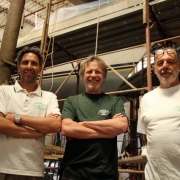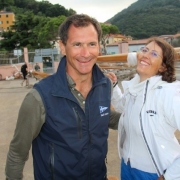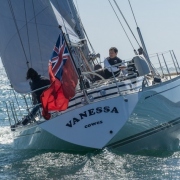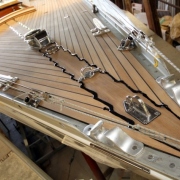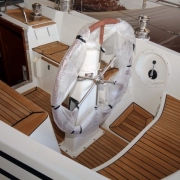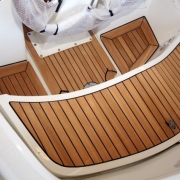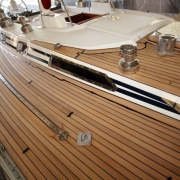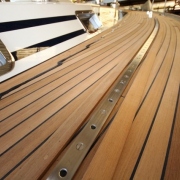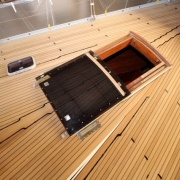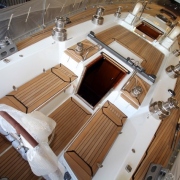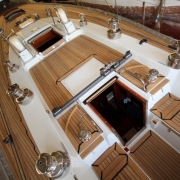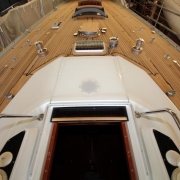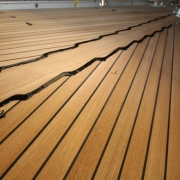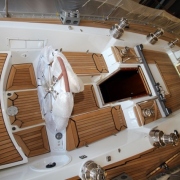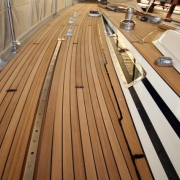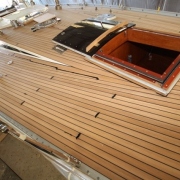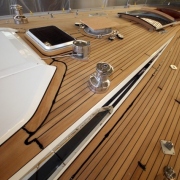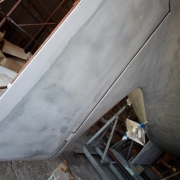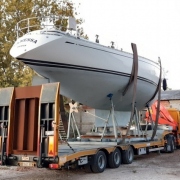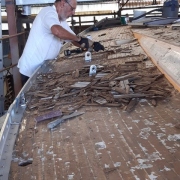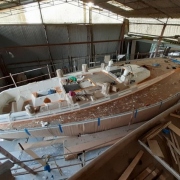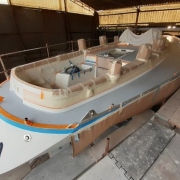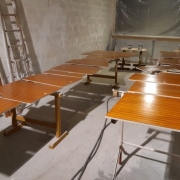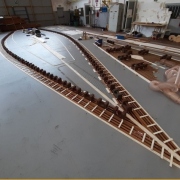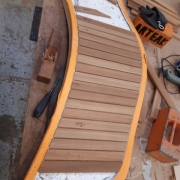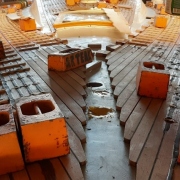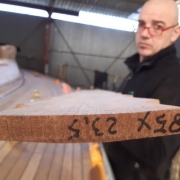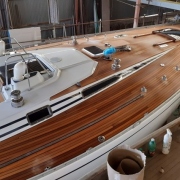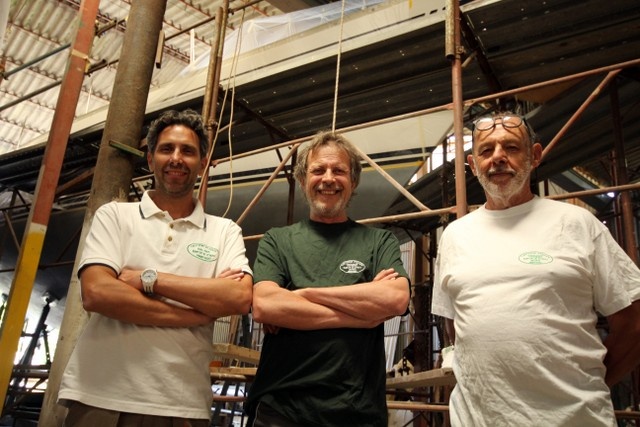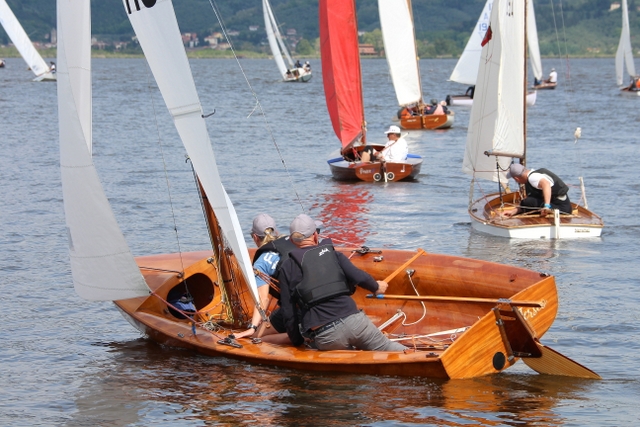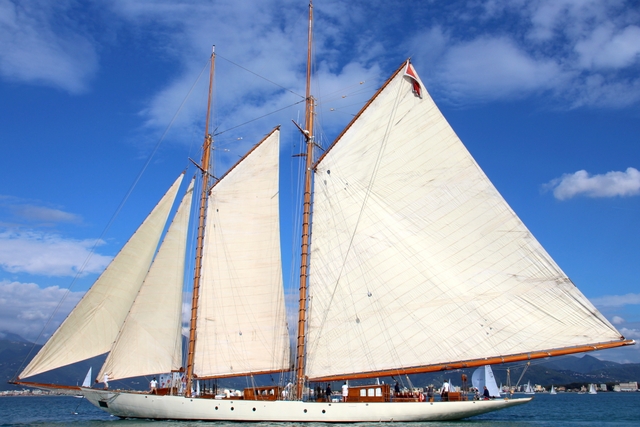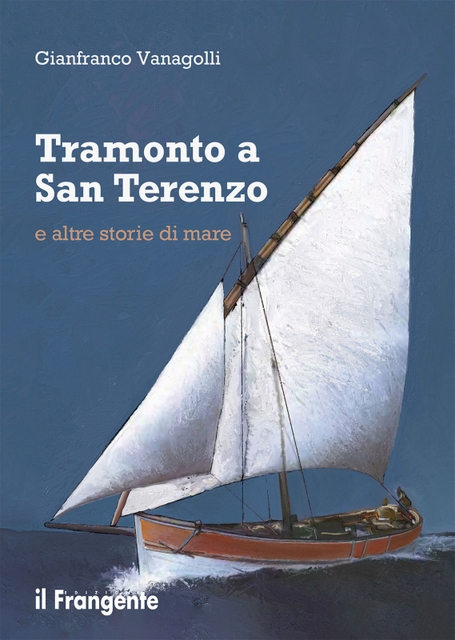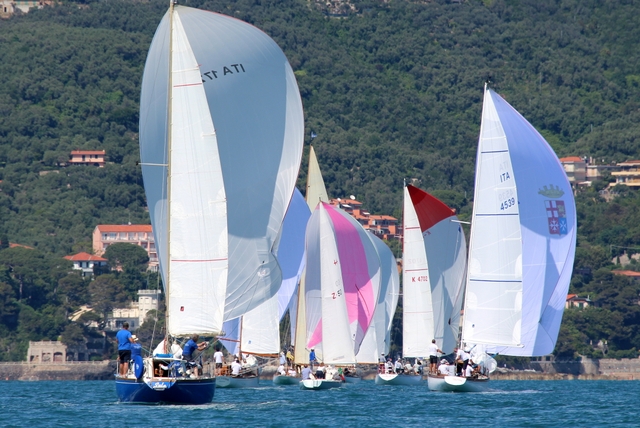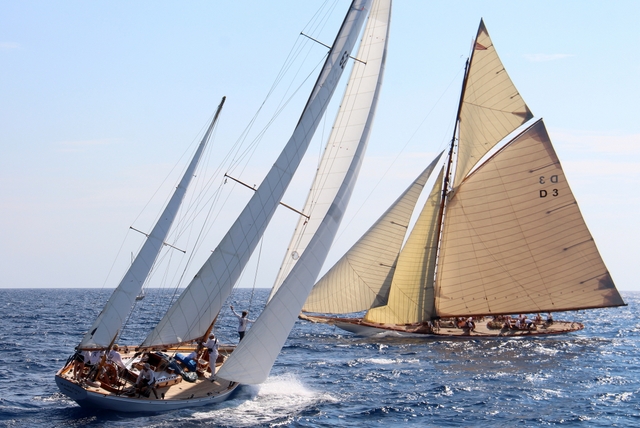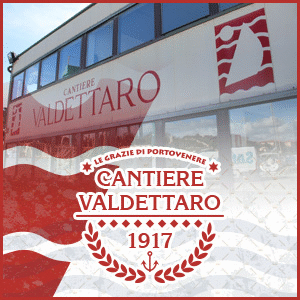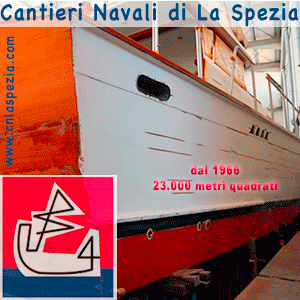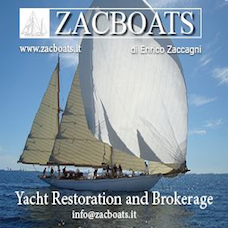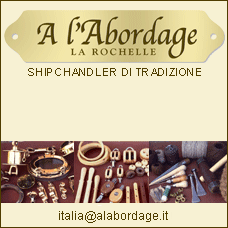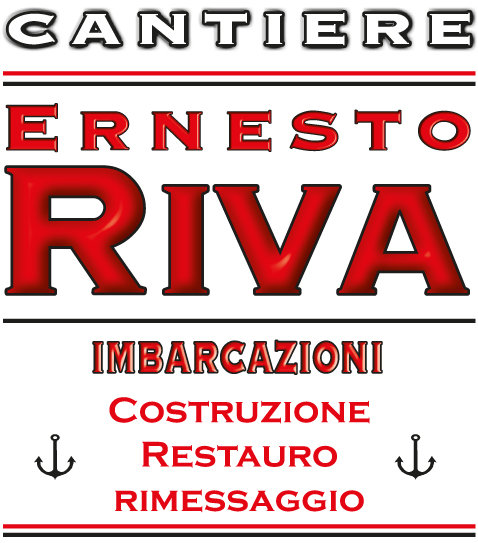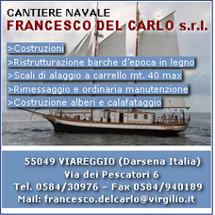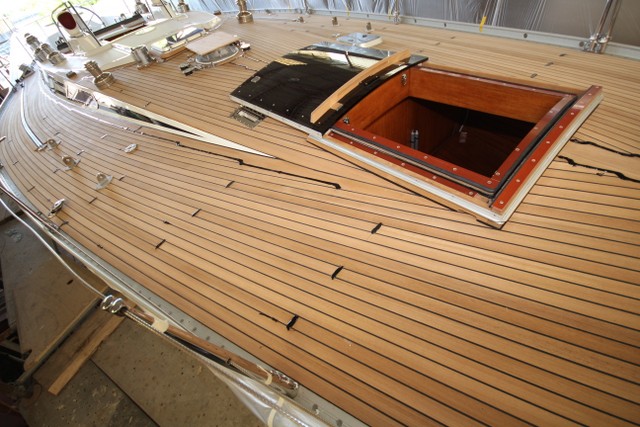 Come si posa una nuova coperta in teak? Ecco il racconto di quanto eseguito a bordo di Vanessa, un modello di Swan 47 varato nel 1985. La barca è stata oggetto di importanti lavori eseguiti recentemente dal Cantiere Pezzini di Viareggio per conto del fondatore della Sparkman & Stephens Swan Association, il sodalizio che riunisce gli armatori degli oltre 800 Swan realizzati su piani dell’omonimo studio di progettazione americano. Da circa un ventennio questo sodalizio internazionale, con sede a Milano, è diventato il punto di riferimento mondiale per questa categoria di imbarcazioni, entrate di diritto nella storia della nautica da diporto.
Come si posa una nuova coperta in teak? Ecco il racconto di quanto eseguito a bordo di Vanessa, un modello di Swan 47 varato nel 1985. La barca è stata oggetto di importanti lavori eseguiti recentemente dal Cantiere Pezzini di Viareggio per conto del fondatore della Sparkman & Stephens Swan Association, il sodalizio che riunisce gli armatori degli oltre 800 Swan realizzati su piani dell’omonimo studio di progettazione americano. Da circa un ventennio questo sodalizio internazionale, con sede a Milano, è diventato il punto di riferimento mondiale per questa categoria di imbarcazioni, entrate di diritto nella storia della nautica da diporto.
ITALIAN / ENGLISH TEXT
Di Paolo Maccione – Giugno 2020
Foto Paolo Maccione e Archivio Cantiere Pezzini
VANESSA, IL VIDEO
VANESSA, IL SESSANTANOVESIMO SWAN 47
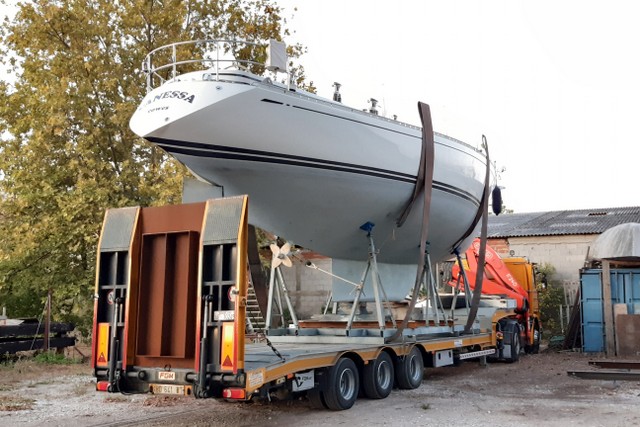 L'ingresso dello Swan 47 Vanessa presso il Cantiere Pezzini di Viareggio
L'ingresso dello Swan 47 Vanessa presso il Cantiere Pezzini di Viareggio
Vanessa è uno degli 824 Swan, progettati dallo studio newyorchese Sparkman & Stephens, usciti dal cantiere finlandese Nautor a partire dal 1966. Ben quindici le categorie di Swan in cui è stata suddivisa la vasta produzione, dal piccolo Swan 36, lungo 10,91 metri e realizzato tra il 1967 e il 1970, allo Swan 76, lungo 23,26 metri e prodotto tra il 1979 e il 1981. Vanessa, lunga 14,57 metri, scesa in acqua nel marzo 1985, è il 69esimo modello di Swan 47 sui 70 costruiti. Fino al 2015 ha avuto un unico proprietario di nazionalità tedesca, che l’ha fatta navigare principalmente nel Baltico e per due volte ha circumnavigato la Gran Bretagna. Il nuovo armatore, il mercante d’arte milanese Matteo Salamon, fondatore e coordinatore della Sparkman & Stephens Swan Association, ha deciso di affidare al Cantiere Pezzini di Viareggio, in Toscana, l’intervento di sostituzione della coperta. Dopo 35 anni anche barche di questo genere, nonostante la solida costruzione in vetroresina, necessitano di una sosta prolungata in cantiere per permetterle di tornare belle come al momento del varo. L’incontro con lo storico cantiere è avvenuto a fine 2018 tramite Michele Frova, comandante di Ojala II, un altro Sparkman & Stephens costruito in alluminio nel 1973 dal cantiere olandese Royal Huisman, vicino di banchina di Vanessa a Porto Lotti, La Spezia, dove entrambe fanno base. Frova non aveva mancato di elogiare le capacità dei maestri d’ascia viareggini, già protagonisti del rifacimento della nuova coperta di Ojala II.
LA RIMOZIONE DELLA VECCHIA COPERTA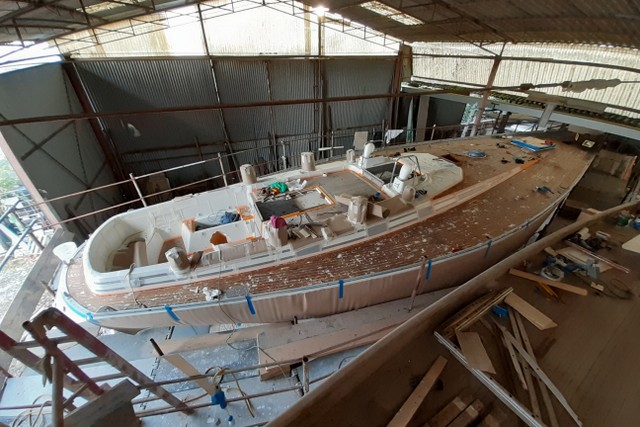 Lo Swan 47 Vanessa presso il Cantiere Pezzini di Viareggio
Lo Swan 47 Vanessa presso il Cantiere Pezzini di Viareggio
Ad agosto 2019 Vanessa è arrivata a Viareggio per essere disalberata. Lo scafo ha raggiunto via terra la sede del Cantiere Pezzini in Via Paladini, mentre l’albero è stato trasferito presso la Velscaf di Carasco (GE), l’azienda del noto navigatore Franco ‘Ciccio’ Manzoli per le operazioni di sabbiatura, riverniciatura e sostituzione del sartiame. Un anno prima, presso la ditta Arteak di Viareggio di Massimilliano Barontini e Marco Guidi, era stato già selezionato il legno di teak rigatino di prima qualità, circa mezzo metro cubo, necessario per realizzare i 37 metri quadrati della nuova coperta di Vanessa. Dopo una stagionatura durata circa 12 mesi, il legno era pronto per essere lavorato. Una volta effettuato lo smontaggio e la classificazione dell’attrezzatura di coperta da parte del tecnico Elio Borio di La Spezia, si è provveduto innanzitutto a rimuovere il vecchio ponte in teak tramite tagli trasversali e scalpellature. La vecchia coperta era interamente avvitata con 3.000 viti in acciaio inox e altrettanti tappi in legno. Una volta eliminate le viti, i fori sono stati sigillati con piccole caviglie in legno bagnate nella resina epossidica, inserite nei fori e rasate a filo. La sede della nuova coperta è stata quindi molata e trattata con fondo isolante epossidico allo scopo di isolarla e garantire l’adesione del collante per quella nuova.
LA POSA DEL NUOVO TEAK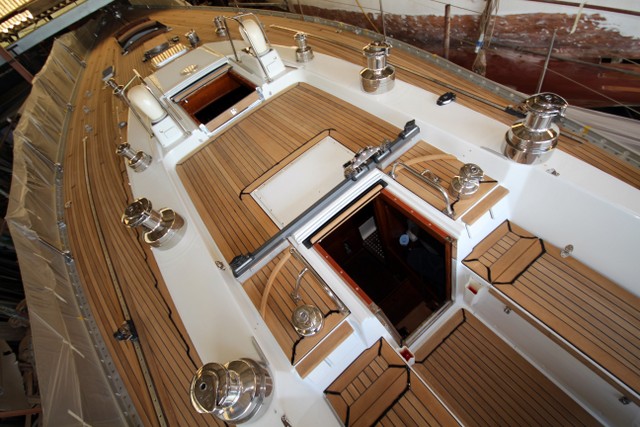 La nuova coperta in teak di Vanessa qualche giorno prima dell'uscita dal Cantiere Pezzini (Foto P. Maccione)
La nuova coperta in teak di Vanessa qualche giorno prima dell'uscita dal Cantiere Pezzini (Foto P. Maccione)
A partire da novembre 2019 Arteak ha realizzato le componenti della nuova coperta (pozzetto, tuga, camminamenti laterali e panche), tramite dime in compensato. Il simulacro, tracciato sul pavimento, ha consentito di predisporre fasce di doghe dello spessore di 12 millimetri. Ogni doga ha una larghezza di 4,2 centimetri e una lunghezza massima di 6 metri, con le attestature (dove termina una doga e ne inizia un’altra) tagliate all’inglese (ortogonali rispetto alla linea di chiglia). Le fasce più lunghe predisposte dalla Arteak arrivavano anche fino a 15 metri. Per riempire i comenti tra una doga e l’altra e per gli incollagi sono stati utilizzati prodotti Sikaflex. Tramite apposite tabelle tecniche, che tengono conto di temperatura e umidità, sono state stabilite le tempistiche per la posa del teak a bordo. Il tempo totale per la realizzazione della nuova coperta è stato di circa 6 mesi. Il nuovo ponte, se trattato adeguatamente, soprattutto se spazzolato trasversalmente rispetto all’andamento longitudinale delle doghe, potrebbe durare ben oltre 15/20 anni. Alle attività di cantiere hanno partecipato in prima persona il titolare Massimo Pezzini, lo zio Sandro Pezzini e il viareggino Luca Sessa, l’operaio specializzato presente in cantiere dalla fine degli anni Ottanta.
GLI ALTRI INTERVENTI A BORDO DI VANESSA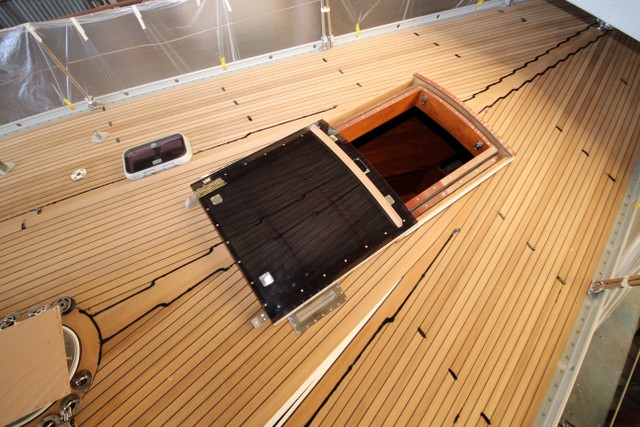 Il rinnovato boccaporto di prua di Vanessa (Foto P. Maccione)
Il rinnovato boccaporto di prua di Vanessa (Foto P. Maccione)
La presenza in cantiere ha offerto l’opportunità di compiere una serie di lavori supplementari che hanno consentito all’imbarcazione di tornare come al giorno del varo. Tra questi la pulizia e riverniciatura delle sentine, previa asportazione delle casse acqua e casse batterie, il ripristino del tappo di aleggio delle sentine in corrispondenza del bulbo, la rimozione di una presa a mare non più utilizzata, la revisione dell’impianto idraulico, il tagliando del motore, la posa di un nuovo scarico motore in acciaio inox e la revisione dei meccanismi del bow-thruster e del salpancore. Sottocoperta sono stati riverniciati tutti i paglioli con vernice poliuretanica bicomponente trasparente e trattati con olio i legni degli arredi. In coperta, infine, sono state ricostruite le fonti in legno di teak del boccaporto di prua, sostituite le guarnizioni dei boccaporti con altrettante originali del cantiere Nautor, sostituiti i plexiglass dei 3 boccaporti e tutte le guide in segaleo (Tufnol). Vanessa è tornata a navigare a giugno 2020. Al termine del restauro l’armatore Matteo Salamon ha dichiarato: “Abbiamo acquistato Vanessa nel 2015, con lo scopo di riportarla agli originali splendori entro cinque anni. Siamo nel 2020 e possiamo dire di avere rispettato i tempi. Anzi, … ci siamo “lasciati scappare un po’ la mano” per quanto riguarda la qualità dei lavori eseguiti. Oggi, lo dico senza falsa modestia, credo che Vanessa sia uno dei 2, 3 S&S Swan più belli del pianeta. Libelula, il trentatreesimo Swan del raggruppamento Swan 65 di proprietà del mio caro amico Placido Arango è un po’ più bella. Noblesse Oblige.”
IL CANTIERE PEZZINI DI VIAREGGIO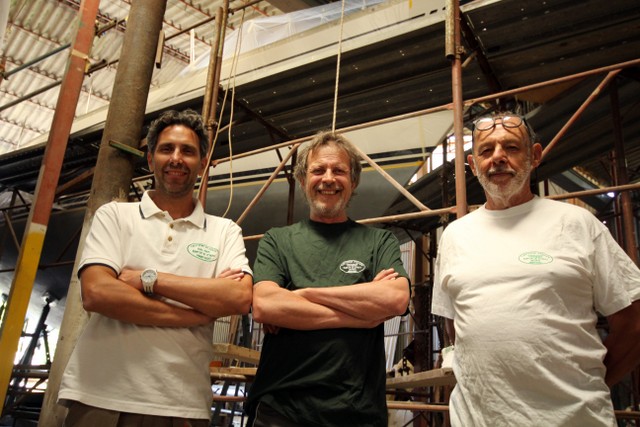 Il Cantiere Pezzini di Viareggio: da sinistra, Luca Sessa, Massimo Pezzini e Sandro Pezzini
Il Cantiere Pezzini di Viareggio: da sinistra, Luca Sessa, Massimo Pezzini e Sandro Pezzini
Il cantiere Pezzini di Viareggio (www.cantierepezziniviareggio.it), maestri d’ascia da quattro generazioni, è una delle realtà più note e apprezzate a livello internazionale nel settore del recupero delle imbarcazioni d’epoca e classiche. Fondato nel 1905 da Attilio Pezzini è poi passato al figlio Egidio Pezzini, classe 1905, e successivamente al figlio Attilio, classe 1935, chiamato come il nonno. Un tempo qui si costruivano dagli scafi per il trasporto della sabbia ai pescherecci. Da alcuni decenni invece si recuperano yacht da crociera, scafi da regata e derive storiche della Classe ‘A’ e Classe ‘U’ (tra cui Regina e Perseo). Oggi l’attività prosegue grazie al figlio Massimo Pezzini, classe 1960, titolare insieme allo zio Sandro Pezzini. Innumerevoli i restauri eseguiti negli ultimi 40 anni, dal 6 Metri S.I. (Stazza Internazionale) Mirabellissima agli 8 Metri S.I. Margaret del 1926 e Bamba del 1927, dallo sloop Ganbare e il One Tonner Ojalà II, entrambi del 1973, al 5.50 Metri S.I. Violetta VI del 1961 e Artica II, lo yawl del 1956 della Marina Militare. Qui sono stati recuperati anche Ausonia del 1948 e Blue Mallard del 1949, i primi due Dragoni immatricolati in Italia, e il Folkboat Pinocchio.
Tra le nuove costruzioni realizzate a partire dagli anni Settanta diversi Half Tonner, One Tonner e Two Tonner disegnati dai più noti progettisti come Bruce Farr (Piccola e il classe libera del Garda Grifo), Andrea Vallicelli (Moments), Francesco Budini Gattai (Giglio Rosso, Lorenzo il Magnifico e Fantaghirò), Ron Holland (Schiffini II), Philippe Briand (Amarcord), Massimo Paperini (Robadapazzi). Senza dimenticare i gozzi in legno da 5 a 7,20 metri, il motorsailer Arianna lungo 9,50 metri, un motoryacht tipo Grand Banks lungo 12 metri progettato da Ugo Faggioni o il primo prototipo dello Show 42 in legno lamellare. A metà degli anni Novanta sono stati anche ricostruiti i due alberi del ketch Capitan Lipari del 1947, spezzatisi in seguito a una tempesta. Nel 1986 Attilio Pezzini ha ricevuto un premio speciale dalla Camera di Commercio di Lucca quale riconoscimento alla nobile arte del maestro d’ascia. Nel 2006 è stata la volta di Loby 33’, una Lobsterboat in legno lunga 9,95 metri, realizzata in sottovuoto con fasciame in lamellare di compensato marino e mogano a sandwich, con l’anima in PVC espanso. Attualmente è in corso il restauro di Mait II, storico yawl di Sparkman & Stephens del 1957 appartenuto al Commendatore Italo Monzino, fondatore della Standa e mecenate dell’omonimo Centro cardiologico di Milano.
LA SPARKMAN & STEPHENS SWAN ASSOCIATION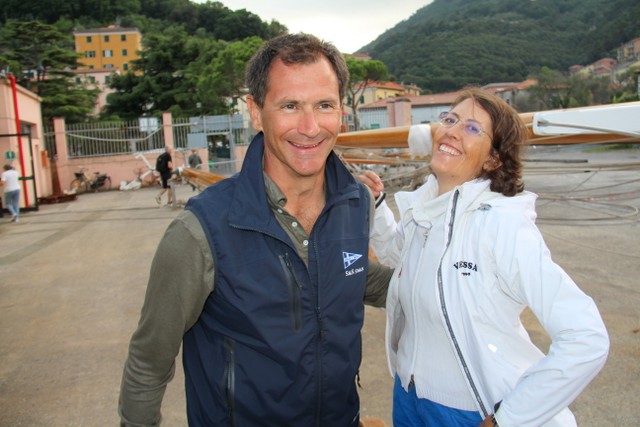 Matteo e Giulia Salamon (Foto P. Maccione)
Matteo e Giulia Salamon (Foto P. Maccione)
La “S&S Swan Association” è composta dagli armatori di imbarcazioni a vela Swan costruite dal cantiere finlandese Nautor su progetto dello studio Sparkman & Stephens di New York. Dal 1966, anno di fondazione della Nautor, sono stati 824 gli Swan targati S&S prodotti dal cantiere, quasi tutti sopravvissuti e naviganti nei mari del globo. Il sodalizio, fondato nell’anno 2001 dal mercante d’arte milanese Matteo Salamon insieme all’amico Stefano Cioni (1958-2015), conta oggi oltre 610 membri distribuiti in più di 20 nazioni, tra cui Svezia, Germania, Inghilterra, Italia, Spagna, Grecia, Cile e Brasile. Tra gli scopi associativi quello di condividere con gli amanti e gli ammiratori di tutto il mondo la passione nei confronti di questi scafi, che ogni due anni si ritrovano in Mediterraneo per dare vita a un raduno-regata a loro riservato. Il sito web dell’associazione (www.classicswan.org) è diventato un punto di riferimento e una fonte inesauribile di informazioni per la manutenzione degli S&S Swan. Presidente onorario della “S&S Swan Association” è il finlandese Pekka Koskenkylä, fondatore della Nautor.
GALLERY
VISITA IL SITO
www.cantierepezziniviareggio.it
www.classicswan.org
ENGLISH TEXT
The Pezzini yard lays a new teak deck for Vanessa
How do you lay a new teak deck? Here’s how it was done at the Cantiere Pezzini in Viareggio for Vanessa, a Swan 47 from 1985. The refit was undertaken by the yard for the owner of Vanessa, founder of the Sparkman & Stephens Swan Association. The Association represents more than 800 owners of Swans designed by the famous American firm; in the twenty years since it’s foundation in Milan, the S&S Swan Association has become the global reference point for these yachts, an essential part of the history of yachting.
VANESSA, THE 69th SWAN 47
Vanessa is one of 824 Swans built by the Nautor yard in Finland and designed by S&S in New York. These designs can be divided into sixteen categories, from the Swan 36 (10.91 meters long and built between 1967 and 1970) to the Swan 76 (23.26 meters long and built between 1979 and 1981). Vanessa, with an overall length of 14.57 meters, was launched in March 1985: the 69th out of the 70 built of the legendary Swan 47. Her first owner kept her for thirty years, sailing primarily in his home waters of the Baltic, but also completing two circumnavigations of the British Isles. In 2015 Vanessa left Germany for the Mediterranean and her new owner, Matteo Salamon. An art dealer based in Milan, founder and coordinator of the Sparkman & Stephens Swan Association, Salamon commissioned the Cantiere Pezzini in Viareggio to replace Vanessa’s teak deck. After 35 years, even a solidly built Swan should undergo a careful refit to restore her to her original beauty. Matteo was introduced to the Tuscan yard in 2018 by Michele Frova, skipper of Ojala II. Built of aluminum in 1973 by the Dutch yard Royal Huisman, and moored near Vanessa in Porto Lotti (La Spezia), this S&S design had her new deck laid by the shipwrights at the Pezzini yard, and Frova didn’t hesitate to recommend them to Salamon.
REMOVING THE OLD DECK
Vanessa’s mast was taken out in Viareggio in August 2019. While her hull was moved overland to the Pezzini yard in Via Paladini, the mast was sent to Franco “Ciccio” Manzoli’s Velscaf in Carasco, near Genoa, for sandblasting, painting and new shrouds and stays. The 37 square meters of Vanessa’s deck required about ½ cubic meter of first choice vertical grain teak; it had been chosen the year before at Massimilliano Barontini and Marco Guidi’s Arteak in Viareggio. After curing for 12 months, the new wood was ready to be cut. Elio Borio from La Spezia had already stripped and catalogued all the deck hardware; the old teak deck was removed by chisels and crosscutting. More than 3,000 stainless steel screws were taken out, their holes sealed with dowels covered with epoxy resin and leveled off. The underlying deck was then ground smooth and given a separation layer of epoxy, providing insulation and a good surface for gluing the new deck.
LAYING THE NEW DECK
Beginning in November 2019, Arteak began to prepare the elements of the new deck (cockpit, coachroof, side-decks and seating) with plywood jigs. A full size mockup, drawn on the floor, was used to lay out the 12mm thick teak planks, five at a time. Each plank was 4.2cm wide, with a maximum length of six meters, with each plank butt-cut perpendicular to the yacht’s centerline. The longest groups were almost 15 meters long. Sikaflex products were used for seams and for glueing, accurately monitoring temperature and humidity as indicated. Six months were needed to lay the whole deck. If properly cared for, a new deck can last for more than 15 to 20 years. The work was carried out by the owner of the yard, Massimo Pezzini, his uncle Sandro Pezzini, and Luca Sessa, a thirty year veteran of the Pezzini yard.
OTHER JOBS ABOARD VANESSA
Once in the yard for her new deck, several other jobs were carried out on Vanessa to bring her back to pristine condition: the bilges were cleaned and repainted after removing the fresh-water tanks and batteries; an unused seacock removed; the hydraulic system, bow thruster and anchor windlass were overhauled; the engine serviced and given a new stainless-steel exhaust system. For the interiors, the floorboards were painted with two-component transparent polyurethane and all the woodwork oiled. On deck, the teak trim of the foredeck hatch was renewed and new original Nautor seals for all deck openings were installed, as was new plexiglass for the three hatches. All the slides for the hatches are now in Tufnol. Vanessa was ready to sail again in June 2020. After the refit, Matteo Salamon stated: “We bought Vanessa in 2015, with the goal of bringing her back to her original condition within five years. It’s 2020 and we can now say that we managed on schedule. To tell the truth, we even got a bit carried away with the quality of the work done. Modestly speaking, I think we can say that Vanessa is one of the two or three most beautiful S&S Swans on the planet. But Libelula, the 32nd Swan 65, owned by my friend Placido Arango, might beat her. Noblesse Oblige!”
THE CANTIERE PEZZINI IN VIAREGGIO
The Cantiere Pezzini shipyard in Viareggio (www.cantierepezziniviareggio.it) vaunts four generations of shipwrights and today is an internationally known and popular yard for classic and vintage yacht restorations. Founded in 1905, the yard passed from Attilio Pezzini to his son Egidio Pezzini, and then to the founder’s grandson, also named Attilio. From building fishing boats and lighters for transporting sand in the early 1900’s, the yard’s business evolved over the years and since the 1990’s has specialized in classic yacht restoration. Managed by the founder’s great-grandson Massimo Pezzini and his uncle Sandro Pezzini, many important refits have been completed over the last 40 years: from the 6 Meter Mirabellissima to the 8 Meters Margaret (1926) and Bamba (1927); from Doug Peterson’s Ganbare and the One Tonner Ojalà II (both from 1973) to the 5.5 Meter Violetta VI (1961) and the Italian navy’s yawl Artica II (1956). Along with the historic A Class and U Class dinghies Regina and Perseo, the yard also restored the first Dragons to sail in Italy, Ausonia (1948) and Blue Mallard (1949), and the Folkboat Pinocchio.
During the 1970’s the Pezzini yard completed many new builds for the yacht racing scene, Half Tonners, One Tonners and Two Tonners, designed by Bruce Farr (Piccola and the Open class Grifo), Andrea Vallicelli (Moments), Francesco Budini Gattai (Giglio Rosso, Lorenzo il Magnifico and Fantaghirò), Ron Holland (Schiffini II), Philippe Briand (Amarcord) and Massimo Paperini (Robadapazzi).
As if this wasn’t enough, Pezzini also built ‘gozzi’ from 5 to 7 meters in length, the 9.5 meter motorsailor Arianna, a 12 meter Grand Banks style motoryacht designed by Ugo Faggioni, the first prototype of Vallicelli’s Show 42 in cold-molded wood, and two new masts for the 1947 ketch Capitan Lipari, dismasted in a storm.
In 1986 Attilio Pezzini was awarded a special mention from Lucca’s Chamber of Commerce for his activity as a shipwright. In 2006 the yard built the Loby 33, a cold-molded vacuum built lobster boat in marine ply and mahogany sandwich with a PVC core. Today the complete refit of Mait II, the historic S&S yawl from 1957 campaigned by Italo Monzino, is keeping everyone busy.
THE SPARKMAN & STEPHENS SWAN ASSOCIATION
The membership of the S&S Swan Association is made up of owners of the Nautor Swans designed by Sparkman & Stephens. Since the creation of Nautor in 1966, 824 S&S designed Swans have been launched, and almost all are still sailing today. The non-profit Association, founded in 2001 by Matteo Salamon and Stefano Cioni (1958-2015), now counts more than 600 members, from more than 20 countries, including Sweden, Germany, England, Italy, Spain, Greece, Chile and Brazil. The purpose of the Association is to share the collective passion for these wonderful yachts, and they all meet every two years in the Mediterranean for a rendezvous and regatta. The association’s website (www.classicswan.org) has become a reference point and a limitless source of information for their maintenance and up-keep. The honorary president of the S&S Swan Association is Pekka Koskenkylä, the founder of Nautor Yachts.




